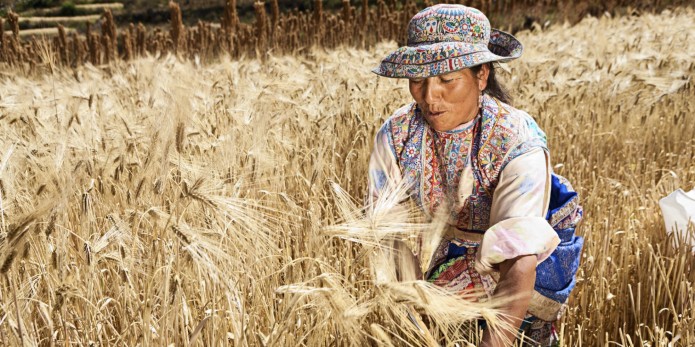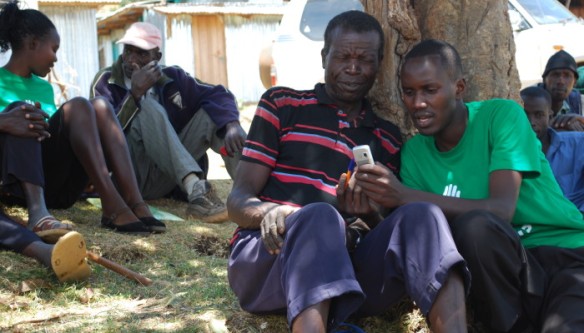
Woman farming in Peru (Bartosz Hadyniak via Getty Images)
The rise of the SMS, or short message services, has enabled people to instantaneously connect with each other. An astonishing 6 billion people worldwide now have access to cellphones—it’s safe to say that they have quickly become the global norm. We are now beginning to see the use of text messages rapidly expanding beyond casual conversations and evolving to become much more valuable.
Kepha is a farmer in rural Kenya. His 52 chickens support his family as a source for food, but also as a primary means of income. Upon discovering that his chickens had suddenly fallen ill, he knew he needed to act quickly or risk losing his family’s livelihood. Kepha, like many people in the world, does not have access to the Internet, but he does have a cellphone. What if he could use his cellphone to get recommendations and input from farmers like him around the world to find a solution to his problem?
Last week, National Geographic Voices blog described the success of WeFarm, a non-profit organization responsible for connecting farmers worldwide via SMS to tackle problems just like the one Kepha faced. WeFarm empowers farmers with quick and easily accessible peer-to-peer solutions. It claims to be “the Internet for people who do not have the Internet” and provides a valuable means of free knowledge exchange. According to their website, there are already over 30,000 users and over 3 million SMS have been exchanged so far. Kepha used his cellphone to text his questions to WeFarm and with the help of another farmer, managed to save half of his chickens and his livelihood. Kepha describes WeFarm as “a really great service, you ask a question and in less than 10 minutes you have an answer. It has also motivated me in farming knowing that other farmers are out there doing similar things”. For more on Kepha’s story, as well as other farmer’s, click here.
Often times, small-scale farmers without access to Internet, like Kepha, have no other choice, but tackle their agricultural issues on their own. Limited by resources and expertise available in their communities or regions, farmers can be trapped in very vulnerable positions. WeFarm’s service is exciting because it is a shift away from a top-down approach of knowledge exchange, predominantly from the Global North to the Global South. It facilitates agricultural education outside the classroom, without the need for training programs or funding from outside institutions. Soil solutions from a farm in Peru may be relevant to a farmer’s erosion problem in Tanzania and now communication between the two is made possible at no cost to the farmers.

Kepha reading a WeFarm SMS (WeFarm)
This initiative is an attempt to thread together a global partnership of empowered farmers and people. Solutions are solutions adapted from small-scale farms for small-scale farms. By drawing from traditional or innovative fixes from all around the world, it realizes the value of every individual and their experiences. The service is limited by the language capabilities of it volunteers, but it endeavors to make the SMS exchange as accessible as possible by including Swahili, Spanish, French, and English.
Technology can be transformational, Wired and The Atlantic also written interesting pieces about the promising future of SMS and its role as a financial, commercial, health, and educational tool. Technological innovations; however, have their limitations. They can open new doors and possibilities, but must be supplemented by infrastructural changes that similarly thrive to improve the wellbeing for all people. In any case, farmers all around the world are finally being given a voice and can use their expertise to help others and is a much needed alternative to the Global North telling the Global South what is best for them. If this is what can be done with features phones, as ever more people make the transition to smartphones, what will be next?
References
Alba, D. (2015, July 14). SMS loans let people skip banks in the developing world. Wired. Retrieved from http://www.wired.com/2015/07/zidisha/
Banks, K. (2015, November 10). Seeds, soils and SMS: how mobiles promote resilience among small-scale farmers in africa. National Geographic Voices. Retrieved from http://voices.nationalgeographic.com/2015/11/10/seeds-soil-and-sms-how-mobiles-promote-resilience-among-small-scale-farmers-in-africa/
Chhabra, E. (2015, November 6). Farmers are sharing tricks of the trade across continents via SMS. Take Part. Retrieved from https://www.takepart.com/article/2015/11/06/wefarm
Holmes, J. (2011, August 2) Why tecting is the most important information service in the world. The Atlantic. Retrieved from http://www.theatlantic.com/technology/archive/2011/08/why-texting-is-the-most-important-information-service-in-the-world/242951/
Riera, M. (2012). Introduction to WeFarm. Retrieved from https://vimeo.com/41066261
UN News Centre (2013, March 21), Deputy UN chief calls for urgent action to tackle global sanitation crisis. UN News Centre. Retrieved from http://www.un.org/apps/news/story.asp?NewsID=44452#.Vk9cEmBvnjK
WeFarm (2015). Case studies – WeFarm. WeFarm. Retrieved from http://wefarm.org/case-studies/

Hi! This turns out to be really interesting! And indeed, the first thing that I thought is that this is a horizontal approach, and not a vertical (top-down) one. This makes it really interesting. I ended up being a little bit more interesting about how it operates in terms of languages, and how come they have answers in just 10 minutes. Also, if people end up being more dependent on it: instead of creating their own solutions, they just ask wefarm and in just 10 minutes, problem solved. Would something like this happen eventually?
LikeLike
Dee, I found this post extremely interesting with the backdrop of the year I spent in a rural, agricultural community in Tanzania. The use of technology, even in very remote and rural areas, has so much potential to support farmers like Kepha. The organization I worked for partnered with Kariokoo, the largest market in Tanzania, and a major cell phone company, to create a system where farmers can text in a code and instantly receive the latest data about the price of a particular crop on that day. Individuals can begin to get better prices on their crops based on this data. I am very intrigued and excited about the WeFarm approach as well! My question, though, would be whether there is some sort of screening process for which answers are sent back to the farmers. Just because a solution worked in one place does not mean it would in another, given the microclimate of the area and other regional characteristics that could be at play.
LikeLike